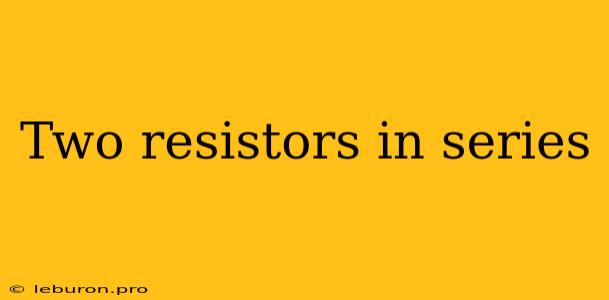Understanding how resistors behave when connected in series is fundamental in electronics. When two resistors are connected in series, they form a single path for current to flow through. This means that the same current passes through both resistors, regardless of their individual resistance values. This simple arrangement has a significant impact on the overall resistance of the circuit and the voltage drop across each resistor. In this article, we will delve into the concept of two resistors in series, exploring the key principles, formulas, and practical applications of this configuration.
Understanding Series Circuits
A series circuit is a type of electrical circuit where components are connected end-to-end, forming a single path for current to flow. In this configuration, the current flowing through each component is the same. This is in contrast to a parallel circuit, where components are connected side by side, allowing current to flow through multiple paths.
Key Principles of Two Resistors in Series
- Current: The same current flows through both resistors.
- Voltage: The total voltage across the two resistors is equal to the sum of the individual voltage drops across each resistor.
- Resistance: The total resistance of the circuit is equal to the sum of the individual resistances of the two resistors.
Calculating Total Resistance
The total resistance (Rt) of two resistors in series is simply the sum of their individual resistances (R1 and R2):
Rt = R1 + R2
This means that the overall resistance of the circuit increases when resistors are connected in series. This is because the resistors act as obstacles to the flow of current, and adding more obstacles increases the overall resistance.
Voltage Division
When two resistors are connected in series, the voltage across each resistor is proportional to its resistance. This is known as voltage division.
The voltage drop across a resistor (Vr) can be calculated using the following formula:
Vr = (R / Rt) * Vt
Where:
- Vr is the voltage drop across the resistor
- R is the resistance of the resistor
- Rt is the total resistance of the circuit
- Vt is the total voltage across the circuit
Applications of Two Resistors in Series
The configuration of two resistors in series has various applications in electronics, including:
- Voltage Divider: This is a common application of series circuits. By selecting appropriate resistor values, we can create a voltage divider that reduces the voltage from a source to a desired level.
- Current Limiting: Resistors in series can be used to limit the current flowing through a circuit. By adding a resistor in series with a component, we can decrease the current flow through that component.
- LED Circuits: When connecting LEDs to a power source, a series resistor is often used to limit the current flow and prevent damage to the LED.
Advantages and Disadvantages of Two Resistors in Series
Advantages:
- Increased Resistance: By adding resistors in series, we can increase the overall resistance of the circuit. This can be useful for limiting current or controlling the voltage.
- Voltage Division: The series connection allows for the division of voltage, enabling us to obtain different voltage levels within a circuit.
- Simplicity: The series connection is relatively straightforward to implement.
Disadvantages:
- Increased Voltage Drop: Each resistor in series will cause a voltage drop, potentially reducing the available voltage for other components in the circuit.
- Limited Current Handling: The total resistance of the circuit increases in a series connection, which can limit the maximum current the circuit can handle.
Real-World Examples
1. Light Dimmers: A light dimmer typically uses a variable resistor in series with the light bulb. By adjusting the resistance of the variable resistor, the amount of current flowing to the light bulb can be controlled, thus dimming the light.
2. Potentiometers: A potentiometer is a three-terminal variable resistor that can be used as a voltage divider. By adjusting the wiper of the potentiometer, we can change the resistance ratio between two parts of the resistor, resulting in a variable output voltage.
3. Automotive Circuits: In automotive applications, resistors are used in series with various components like headlights, brake lights, and other electrical systems to regulate the current flow and prevent damage.
Conclusion
Two resistors in series form a fundamental configuration in electronics, offering a simple yet effective method to increase resistance, divide voltage, and limit current. Understanding the principles of series circuits is crucial for designing and troubleshooting electronic circuits. Whether you're a novice hobbyist or a seasoned engineer, grasping the behavior of two resistors in series will enhance your knowledge of electronic circuits. By applying this knowledge, you can create efficient and reliable circuits that meet specific electrical requirements.
